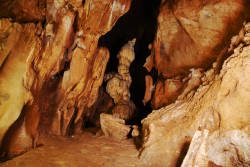Las Cuevas de Talgua
Caves of Talgua - The Talgua Eco-Archaeological Park - Cueva del Río Talgua - Cave of the Glowing Skulls
Useful Information
| Location: |
Guanaja, Olancho Valley, Río Talgua.
10 km north-east of the city of Catacamas, Departamento de Olancho. 800 m walk to the cave. (14.896270, -85.870900) |
| Open: |
All year Tue-Sun. [2004] |
| Fee: |
Lower Cave:
Hondurans HNL 20, Foreigners USD 5. [2004] |
| Classification: |
 Karst Cave Karst Cave
|
| Light: |
 Incandescent Electric Light System Incandescent Electric Light System
|
| Dimension: | T=18-22 °C. |
| Guided tours: |
Lower Cave: L=500 m, D=45 min. Upper Cave: self guided. |
| Photography: | |
| Accessibility: | |
| Bibliography: |
J. E. Brady, G. Hasemann, J.H. Fogarty (1995a):
Harvest of skulls and bones,
Archaeology 18 (3): 36-40.
J. E. Brady, G. Hasemann, J.H. Fogarty (1995b): Secretos escondidos, hallazgos luminosos, Americas 47(4): 6-15. L. Cohen (1986): Explorations of the Río Talgua, NSS News 44 (5): 113-116. Nicholas Herrmann (2002): GIS Applied to Bioarchaeology: An Example from the Río Talgua Caves in Northeast Honduras, Journal of Cave and Karst Studies - ISSN 1090-6924, Volume 64 Number 1: 17-22 - April 2002. online |
| Address: | |
| As far as we know this information was accurate when it was published (see years in brackets), but may have changed since then. Please check rates and details directly with the companies in question if you need more recent info. |
|
History
| 800-1400 B.C. | cave used as an ossuary. |
| 1994-1996 | excavations by the Talgua Archaeological Project. |
| 2018 | museum renovated. |
Description

The Talgua Eco-Archaeological Park is located 10 km north-east of the city of Catacamas. The entrance fee is 20 Lempiras for Honduran citizens and $5 for foreign visitors. The park is closed on Mondays. The park has all the usual facilities, cafe, toilets, museum and a camp site.
The caves are adjacent to the Talgua River and are formed in the Sierra de Agalta limestone which is covered by a tropical deciduous forest. There are two caves open to visitors, the Lower and the Upper (larger) Cave.
The Lower Cave has lights and footpaths and is well decorated with actively growing speleothems. Visitors must use a guide to enter the Lower Cave and a tour takes about 30 to 45 minutes and costs 5 Lempiras.
The Upper Cave, is a large dry fossil system and is self guided, although guides can be hired. There are no lights or footpaths. Allow two to three hours for a visit and bring your own lights.
The Caves of Talgua are the site of the oldest human remains found in Central America (approximately 900 years BC). The caves were apparently used as a burial site for an ancient society. Through the years, mineral deposits that precipitated from drops of water covered the bones causing them to appear phosphorescent in light. The nickname "The Cave of the Glowing Skulls" is derived from the mineral deposit-covered skulls. The remains are currently being studied; and the burial chamber is not on public display at the present time.
Text by Tony Oldham (2004). With kind permission.
- See also
 Search DuckDuckGo for "Caves of Talgua"
Search DuckDuckGo for "Caves of Talgua" Google Earth Placemark
Google Earth Placemark Talgua caves - Wikipedia (visited: 14-FEB-2022)
Talgua caves - Wikipedia (visited: 14-FEB-2022) The Cave of the Glowing Skulls - Atlas Obscura (visited: 15-FEB-2022)
The Cave of the Glowing Skulls - Atlas Obscura (visited: 15-FEB-2022) Talgua Village archaeological site (visited: 14-FEB-2022)
Talgua Village archaeological site (visited: 14-FEB-2022) Cave of the Glowing Skulls (visited: 14-FEB-2022)
Cave of the Glowing Skulls (visited: 14-FEB-2022) Las Cuevas de Talgua, una conexión con los antepasados
Las Cuevas de Talgua, una conexión con los antepasados  (visited: 14-FEB-2022)
(visited: 14-FEB-2022)
 Index
Index Topics
Topics Hierarchical
Hierarchical Countries
Countries Maps
Maps